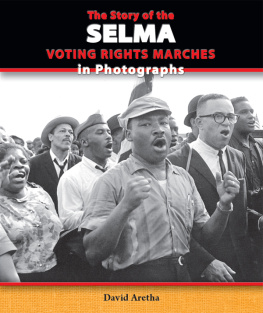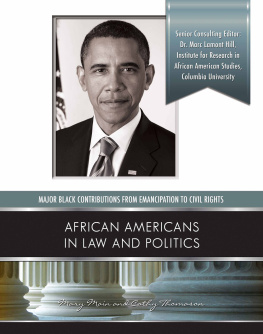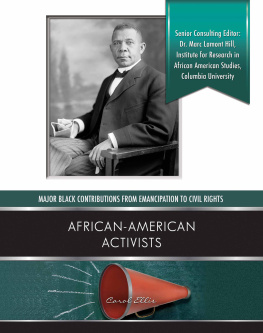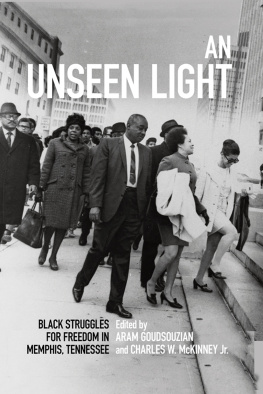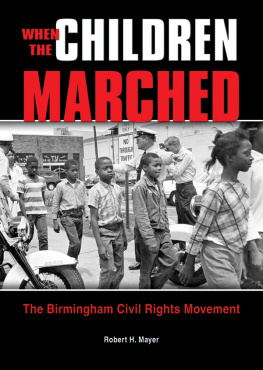
Published by The History Press
Charleston, SC 29403
www.historypress.net
Copyright 2014 by Marie A. Sutton
All rights reserved
Front cover image, top : Dr. Martin Luther King Jr. and others in the Gaston Motel courtyard. Courtesy of the Birmingham Public Library. Bottom : The A.G. Gaston Motel. Courtesy of Chris McNair of Chris McNair Studios .
First published 2014
e-book edition 2014
ISBN 978.1.62585.132.1
Library of Congress Control Number: 2014951890
print edition ISBN 978.1.62619.595.0
Notice : The information in this book is true and complete to the best of our knowledge. It is offered without guarantee on the part of the author or The History Press. The author and The History Press disclaim all liability in connection with the use of this book.
All rights reserved. No part of this book may be reproduced or transmitted in any form whatsoever without prior written permission from the publisher except in the case of brief quotations embodied in critical articles and reviews.
Dedicated to those for whom my heart beatsJames, Simone and Stephen .
All my love to Mama, Daddy, Angie and Marcus
CONTENTS
PREFACE
For most of my life, I walked around thinking that I knew all there was to know about black historymy historybut what I knew was only a scratch on the surface. Although I was a voracious reader and writer, wrote countless stories about Birmingham and prided myself on being versed in the tales of black struggle and empowerment, it wasnt until I was thirty years old that I learned of Birminghams full role in the civil rights movement. It wasnt until then that I awakened from a stupor of ignorance and understood the full impact of the bombing of the historic Sixteenth Street Baptist Church, the Childrens March and public battles.
For that, I am ashamed.
Little did I know that as a native of Birmingham, Alabama, I had walked the same downtown streets and breathed the same sweet southern air as civil rights icons like Reverends Fred Shuttlesworth, Martin Luther King Jr. and others. I didnt know that my high school alma mater was once for whites only and that blacks had to walk past it to attend the one for them, which was farther up the road.
At age thirty, I had the good fortune of working at the Birmingham Civil Rights Institute (BCRI), an educational center devoted to teaching the lessons of the Birmingham movement. When I think about it now, it was divine providence. There, I learned about Birminghams role in the movement, the names of preachers and common folk, tales of the battles at Kelly Ingram Park and downtown.
After learning about what took place in my city and about the key players who came from where I come from, and who looked like I look, pride swelled within me. I come from the stock of people who braved the wrath of Birminghams vehement racist Eugene Bull Connor, who walked into stinging sheets of water used as a weapon, endured threats of death and braced themselves to be bitten by snarling dogsall for the right to be considered full-fledged citizens.
As a child, I had heard a little about A.G. Gaston, the black millionaire who provided jobs for countless Birmingham blacks, but I never knew anything about his motel. I didnt know that the A.G. Gaston Motel was the only place blacks could go for first-class accommodations; that iconic black celebrities like Ike and Tina Turner, Ray Charles and the like slept there; and that it was the headquarters for the Birmingham movement. I didnt even know that my own parents had their wedding reception there. Their 1971 Christmas Eve event was all the talk. My afro-clad father and his groomsmen were dressed in tomato red, crushed velvet tuxedos with sea foam green dress shirts, and my waif-thin mother donned a classic satin gown and was surrounded by her smiling bridesmaids while the Gaston served as the backdrop.
When BCRI archivist Laura Anderson mentioned the place to me and told me about its tales and timelines, the storyteller inside me got excited. I wanted to write a book.
At the time, famous art collector Paul R. Jones, who had managed the motels restaurant during the early 1960s, was coming to Birmingham frequently and agreed to let me interview him for a book. He gave me his phone number and said I was free to come spend time at his house in Atlanta. But I didnt jump on it right away. Then, life happened.
I got married, became pregnant. I got another job and had another baby. Not long after that, Paul Jones died. The idea for the book stalled. Months turned into years. The desire to tell the story, however, never left me. It was like an old debt you know you need to pay; you will not fully rest until its taken care of.
As my fortieth birthday approached, I made the personal commitment to do it. And when I said yes, it was as if I became a magnet for information. What once was a nameless, lifeless place on the corner of town came alive to me.
Suddenly, I would hear the motels name mentioned on television, in lectures and various places. I felt it was confirmation that I am the one who needs to tell the stories.
So I set out on a journey to write about the A.G. Gaston Motel, to venture into the culture and creative spirit of the black race. It became my mission to tell of African Americans who lived, fought and died in Birmingham, Alabamamy homeand how the A.G. Gaston Motel became like a home for activists, celebrities, preachers and common folk when Jim Crow tried to make them homeless.
ACKNOWLEDGEMENTS
For your kind words, swift kicks in the butt, direction, advice, assistance and so much more, I acknowledge you:
Laura Anderson, Dorothy Bailey, Hattie Barnes, Birmingham Civil Rights Institute, Birmingham Public Library, Charles Buchanan, Charla Draper, Andre Elliott, Jimmie Lee Elliott, Marie Elliott, Martez Files, Edna Gardner, Laura Hannah, Tim Hollis, Tamara Harris Johnson, Angela Jones, Marcus Jones, Marlon Jones, Micah Jones, Theresa Jones, Chris McNair, Lisa McNair, Dr. Sarah Parcak, Dr. Robert Smith, Pamela Sterne-King, Amy Sutton, Brenda Sutton, James Sutton Sr. and George A. Washington.
Special thanks to Brenda Jones, who ventured on trips to the library and used her own money to make way too many photocopies for me, who babysat when I needed to write and who constantly offered to help when I did not know what to ask for. I love you.
A big thank you to my dear, sweet daddy: Ill always, always be your number one fan.
Thank you, Kirsten Schofield, Chad Rhoad, Hilary Parrish and The History Press, for giving me a voice (and several extensions).
My eternal gratitude to James, my love: for your prayers, words of encouragement and so much more, I could not have done it without you.
For my life, my words and my everything, I owe it all to youJesus.
INTRODUCTION
How does one go about writing a first-of-its-kind book on a topic that is fascinating but piecemealcommonly known but rarely spoken of? I did not know the answer, but that was my challenge. Boy, was it a challenge.
Although several historical books reference the A.G. Gaston Motel when describing the tumultuous civil rights era in Birmingham, Alabama, there was no one source to go to for comprehensive information. There was only a sentence here, a mention there; a paragraph on this page, a reference on that one.
Many people who would have been adults during its heyday are age eighty and older. Some have died, including the motels namesake and most of its former staff. The ones who are still living have dim memories. Finding the story seemed to be like looking for a lost penny on an endless, sandy beach.


